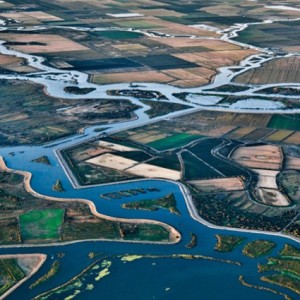Water Is Both Friend & Foe: Down on Wheat, Argentina and Brazil Look Forward to Record Corn Harvests
As drought-ravaged corn supplies wear thin in the United States, global commodity markets are counting on favorable weather — and a big corn crop — in South America.
Argentina and Brazil are looking at record and near-record corn crops, respectively, heading into the very early harvesting season. The crops could be a boon to global grain supplies, drawn down by a severe drought in the United States last summer. But they would also be a welcome boost to the Argentinian and Brazilian agricultural sectors after disappointing wheat harvests.
The two South American agricultural powerhouses are the world’s largest corn exporters next to the United States — with Brazil swapping Argentina for the no. 2 spot for the first time on record last year — and both countries stand to benefit from the weak U.S. corn harvest. Brazil is forecast to harvest 72.5 million metric tons of corn in 2013, which would be the second-largest Brazilian crop on record, and to export 18 million metric tons, according to estimates released by the U.S. Department of Agriculture (USDA) Brasilia Bureau. The International Grains Council predicts Argentina will harvest a record 27.5 million metric tons and will likely export 19.5 million metric tons as the government expands its export quotas.
Globally, harvests of this size may hold down prices and will help to make up for vastly reduced exports from the United States — though, even combined, exports from Argentina and Brazil will still fall short of a typical year’s U.S. exports. The world’s grain supplies, however, will remain tight as consumption of wheat and coarse grains like corn, sorghum, barley, and oats is set to exceed production for the third consecutive year, in part because of severe droughts in some of the world’s biggest bread baskets.
Argentina on the Lookout for Rain
But dry weather is also becoming a growing concern for farmers in Argentina, which experienced a scorching drought last spring that severely curtailed corn production.
“The lack of a good volume of rainfalls is extending over the north belt and its surroundings, which increases corn producers worries about the impact on potential yield of early-seeded plots,” said Bolsa de Cereales, the Buenos Aires Grain Exchange, in its weekly agriculture report on January 24. “Although most of the planted surface is passing through grain-filling stages in good conditions, the scarcity of rains plus the high-temperature registers during January is starting to be a concern when it comes to yield production.”
The corn most at risk from the dryness was planted in late November and is currently in the flowering stage, according to the Bolsa de Cereales report. Heavy rains that lashed the country throughout much of the fall flooded fields and delayed corn and soybean planting by months in some areas near Buenos Aires.
Water Wrecks Wheat
The rain also destroyed wheat crops and delayed harvesting in both Argentina and Brazil. The USDA cut its projections for Argentina’s wheat crop by 4 percent between December and January, as disease claimed some plants and grain quality was damaged.
“Several factors worked into the change in the wheat number this month,” Denise McWilliams, a senior crop-assessment analyst with the USDA, told Circle of Blue in an e-mail. “First, there was some area lost or reduced in yield expectation due to the heavy rains, flooding, [and] difficulty harvesting, particularly to the west in Buenos Aires province. Also, in some areas the heavy rains were followed by strong winds that lodged some fields that were ready for harvest, causing some harvest loss.”
Brazil fared even worse. The country’s wheat production is expected to fall to its lowest level in five years, according to the USDA Brasilia Bureau.
“This sizeable and significant loss is attributed to frosts and constant precipitation during the harvest,” the Bureau said in its January report. Already a major wheat importer, Brazil may this year import 7.4 million metric tons, the most since 2006.
Source: Bolsa de Cereales; International Grains Council; USDA Brasilia Bureau; USDA Foreign Agricultural Service
A news correspondent for Circle of Blue based out of Hawaii. She writes The Stream, Circle of Blue’s daily digest of international water news trends. Her interests include food security, ecology and the Great Lakes.
Contact Codi Kozacek






Leave a Reply
Want to join the discussion?Feel free to contribute!